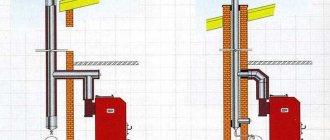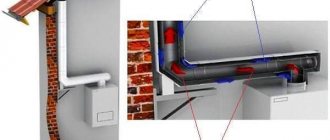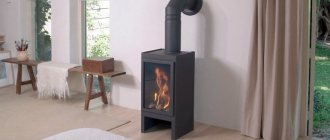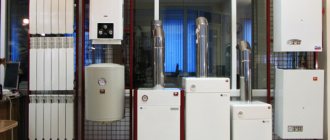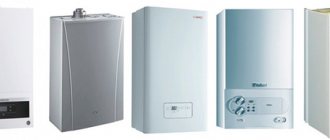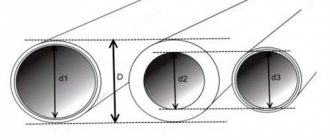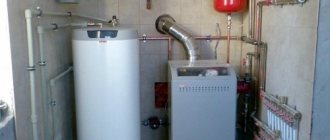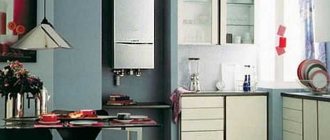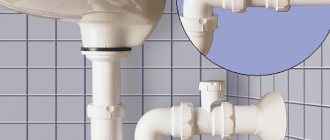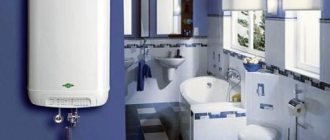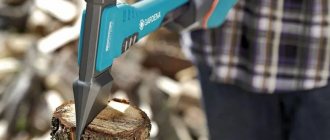Causes of condensation in a stove chimney.
It is believed that for normal operation of a brick stove, the smoke at the exit from the stove into the chimney must have a temperature of at least 250 degrees Celsius.
At this temperature of the flue gases at the entrance to the chimney, at the upper end of the pipe there will be a temperature of about 105 degrees Celsius. (with a well-designed chimney)
This temperature regime allows you to avoid condensation of the chimney.
How to properly install a stove in a garage?
The garage must have normal ventilation to ensure removal of combustion products in case of smoke. You should not install the stove close to the car; the distance should be no less than 1.5 meters.
Interesting materials:
Why is Peterhof closed? Why does ball lightning fly? Why do the keys on my laptop stick? Why does the air conditioner freeze in winter? Why is it asking for a PIN code? Why is broncholithin prohibited? Why are mercury thermometers banned? Why do peony buds dry out? Why does the video freeze on WhatsApp? Why import rabbits to Australia?
General requirements for chimneys
Fireplace inserts can be connected to an existing chimney, but in this case the choice of firebox power is dictated by the cross-sectional area of the smoke duct. General requirements for chimneys are contained in SNiP 41-01-2003 “Heating, ventilation and air conditioning”. This regulatory document allows the use of chimneys made of double-walled steel pipes with thermal insulation made of non-combustible material (at a temperature of exhaust gases not exceeding 500 °C) and the installation of umbrellas, deflectors and other nozzles on chimneys, if these devices do not interfere with the free exit of smoke (in this case its difference from SNiP 2.04.05-91).
The height of the chimneys from the mouth to the grate must be at least 5 m. The height of the parts of the pipes rising above the roof is at least 0.5 m above a flat roof, as well as above a ridge or parapet at a distance of no more than 1.5 m; not lower than the ridge or parapet at a distance of 1.5-3 m; not lower than a line drawn from the ridge downwards at an angle of 10 to the horizontal, with a distance of more than 3 m between the pipe and the ridge.
Pipe bends are allowed at an angle of up to 30 to the vertical at a distance of no more than 1 m. Pipes on buildings with roofs made of flammable materials should be equipped with spark arresters made of metal mesh with holes measuring no more than 5 g 5 mm. The distance from the outer surfaces of brick or concrete chimneys to rafters, sheathing and other roof parts made of flammable materials must be at least 130 mm; from ceramic pipes without insulation - 250 mm, with insulation - 130 mm. As for walls and ceiling elements made of flammable materials, the distance from the inner wall of the smoke duct is standardized: 500 mm to unprotected structures and 380 mm to protected ones.
However, the appendix to SNiP uses the term “cutting”, that is, we are talking about a brick pipe. There are no clear standards for modern modular systems, and developers usually follow the manufacturers' instructions.
Types of chimneys
Brick chimney
Until recently, brick chimneys had virtually no alternative in both urban and rural construction. Being a universal structural material, brick allows you to vary the number of chimney channels and the thickness of the walls (you can make the necessary thickenings in the places where the floors and roofs pass, as well as when constructing the street part of the chimney).
Burda Media
The main problem for an external chimney is good insulation.
Burda Media
A masonry fireplace with an open firebox has a low (15-20%) efficiency, and it is quite difficult to heat a room with its help. But it will help create the atmosphere of a medieval castle in the house.
If construction technologies are followed, a brick chimney is very durable. However, it also has disadvantages. Due to the significant mass (a pipe with a cross-section of 260-130 mm and a height of 5 m, laid out in half a brick, weighs about 1.5 tons), it is necessary to build a foundation. And the construction of this entire structure will require a lot of time and effort. The channel cross-section (rectangular or square) is not optimal for traction. In addition, with periodic use in the cold season, the service life of a brick pipe is greatly reduced due to the aggressive effects of condensation.
To install a brick chimney, very highly qualified builders are required.
Common mistakes during construction
- Choosing low-quality or unsuitable bricks (weakly fired partition or wall bricks).
- The thickness of masonry joints is more than 5 mm.
- Edge laying; the use of stepped (“jagged”) masonry on sloping areas.
- Incorrect preparation of the solution (for example, if the ratio of the parts of clay and sand is chosen without taking into account the fat content of the clay), careless splitting or cutting of bricks.
- Inattentive filling and bandaging of masonry seams (presence of voids and double vertical seams).
Laying pipes close to structures made of combustible materials. The condition of the brick pipe requires constant monitoring. Previously, it was certainly whitewashed, since on a white surface it is easier to notice soot, indicating the presence of cracks.
Alexander Zhilyakov, :
The brick chimney has faithfully served man for centuries. Laying stoves and fireplaces from this material is almost an art. The paradox is that during the period of mass dacha construction in our country, this skill suffered serious damage. The consequences of the “work” of numerous unfortunate stove-makers were sad, and most importantly, they gave rise to distrust of brick fireboxes and chimneys. Therefore, favorable conditions have arisen and continue to exist for the promotion of factory-ready chimney systems to the domestic market.
Steel chimney
Stainless steel pipes can easily be considered the most widely used type of chimney today. Steel modular systems have a number of undeniable advantages. The main ones are light weight, ease of installation, a wide selection of pipes of different diameters and lengths, as well as shaped elements. Steel chimneys are manufactured in two versions - single- and double-circuit (the latter - in the form of a “sandwich” of two coaxial pipes with a layer of non-combustible thermal insulation).
The first ones are intended for installation in heated rooms, connecting a fireplace to an existing chimney, as well as sanitizing old brick pipes. The latter are a ready-made design solution, equally suitable for installing a chimney both inside and outside the building. A special type of stainless steel smoke channels are flexible single- and double-walled (without thermal insulation) corrugated hoses.
For the production of single-circuit chimneys and internal pipes of sandwich-type chimneys, alloyed heat- and acid-resistant sheet steel (usually 0.5-0.6 mm thick) is used. Single-circuit chimneys made of carbon steel, coated outside and inside with special black enamel, are even superior to stainless steel pipes in terms of heat resistance; They are also not afraid of condensation, but only if the coating is intact, which is easily damaged (say, when cleaning a chimney). The service life of uncoated pipes made of “black” steel with a thickness of 1 mm does not exceed 5 years.
Sandwich pipes
The casing (shell) of sandwich pipes is usually made of ordinary (non-heat-resistant) stainless steel, which is electrochemically polished to a mirror finish, and some manufacturers offer enamel painting in any color on the RAL scale. The use of a galvanized steel casing is justified only when installing a chimney inside a building. From the outside, such a pipe, if the chimney is actively used, will not last long: due to periodic heating, corrosion intensifies.
Alexey Matveev, :
Stainless steels used for the production of chimneys are divided into two categories: magnetic ferrite (in the American ASTM standardization system these are AISI 409, 430, 439, etc.) and non-magnetic austenitic (AISI 304, 316, 321, etc.) . According to our tests of AISI 409 steel (composition: 0.08% C, 1% Mn, 1% Si, 10.5-11.75% Cr, 0.75% Ti), the critical temperature value in the inner pipe of the insulated chimney fragment , at which the effect of intercrystalline corrosion became noticeable, was equal to 800-900 C. After 4 hours of exposure, the inner wall of the pipe was covered with a kind of “crocodile skin,” which indicates the beginning of the process of steel destruction. At 650 C no traces of corrosion were observed. The temperature in the pipe rises to 1000 C only when soot ignites (an extreme phenomenon that has a detrimental effect on the condition of almost any chimney). At operating temperatures up to 600 C, a stainless steel chimney can last for decades.
The thermal insulation layer in sandwich pipes solves three problems at once: it prevents overcooling of flue gases from negatively affecting draft, does not allow the temperature of the internal walls of the chimney to drop to the dew point, and, finally, ensures a fire-safe temperature of the external walls.
The choice of insulating materials is small: usually it is basalt wool (or silicone wool, perlite sand (but it can only be filled in during the installation of the chimney).
Rosinox
Sections of pipes made up of several modules that rise above the roof are given stability by making stretch marks.
Burda Media
Steel chimney module
Such a very important characteristic of a chimney as gas tightness depends on the design of the pipe joints, so every manufacturer strives to bring it to perfection. Thus, sealing of some chimneys is ensured by centering couplings; The double annular protrusion formed at the joint is crimped with clamps included in the delivery of each module. Other chimneys have a cone-shaped connection in combination with a ring lip.
The vast majority of stainless steel chimneys are installed in the traditional way, and here a lot depends on the quality of the parts. Typically, the upper module is put on the lower one, but single-circuit, and when laying externally, double-circuit modules should be joined by inserting the upper one into the lower one, which will avoid condensate leakage through the joints.
Ceramic chimneys
Ceramic chimneys are the same “sandwiches”, but “cooked” according to a completely different recipe. The inner pipe is made of fireclay pottery, the middle layer is permanent basalt wool, the outer layer is made of lightweight concrete sections or mirror stainless steel.
Ceramic chimneys are resistant to high temperatures (up to 1000 °C), condensation, and at the same time have the main advantage of modular systems - they can be quickly and easily assembled.
Ceramic systems also have their disadvantages. Chimneys with a concrete casing have a significant mass (1 linear meter weighs from 80 kg), can only be used as main ones (free-standing), and do not allow obstacles to be bypassed. The “weak link” of such chimneys is the connection point. Manufacturers provide for the use of a metal module (modules), which has a shorter service life and therefore will require replacement in the future, which must be taken into account when building a fireplace.
Raab
Raab chimneys with stainless steel inner pipe and concrete casing: with ventilation duct…
Raab
...or without it.
And finally, metal does not combine well with ceramics because it has a high coefficient of thermal expansion: around the perimeter of the steel pipe where it enters the ceramic one, it is necessary to leave a fairly large (about 10 mm) gap, which is filled with asbestos cord or heat-resistant sealant.
However, the high reliability and durability of ceramic chimneys (the factory warranty is 30 years, and the actual service life, according to manufacturers, is more than 100 years) allows us to turn a blind eye to the listed shortcomings.
- Heating
3 simple rules that will help keep your chimney clean and avoid soot fires
Types of systems
The design of sauna stoves includes 2 types of chimneys:
- Indigenous. They are organized next to the stove, using a special pipe for connection, through which the smoke goes into the main channel. One chimney can be used for 2-3 stoves. The main thing is that its internal diameter has the appropriate parameters, and the pipes from each heating device are located at different heights;
- Systems with a mounted pipe are mounted directly on the stove pipe and discharged through the roof. This chimney option is the most common for sauna stoves.
Classification of chimneys according to installation location includes 2 types:
- External. Their main part is located on the street and fixed to the wall using a bracket. They are not particularly recommended for baths, as they quickly cool down, losing precious heat.
- Internal. These are vertical structures with good traction, located inside the building.
Depending on the material used, chimneys are:
- Brick. A traditional look, characterized by labor-intensive masonry and high requirements for compliance with all parameters. They have a lot of advantages: durability, fire safety, strength, good thermal insulation and heat accumulation. Disadvantages include the roughness and angularity of the inner surface on which soot deposits accumulate;
- A metal chimney is faster to install and costs less. It has a perfectly smooth surface, but weaker heat-retaining characteristics;
- A combined version, including 2 parts: the lower one is made of brick, the upper one is made of a modern sandwich pipe. Allows you to organize neat, small passages that are easier to cover with heat-resistant material.
Normal temperature of gases leaving the furnace
In order for the water present in hot gases to evaporate better, the temperature of the latter must be increased. On well-heated pipe walls, settled drops of moisture quickly evaporate.
The normal temperature of gases leaving the furnace before exiting into the pipe is 12O...14O°C, when leaving the pipe into the atmosphere - not lower than 100°C.
If the flue gases, when exiting into the chimney, that is, at the view, reach a temperature of about 250 ° C, then condensation does not form, draft improves, the stoves heat up faster, while consuming less fuel.
The temperature of the exhaust gases can be determined using a dry splinter, which is placed across the view hole during combustion. If after 30...40 minutes you remove the splinter and scrape off the sooty surface from it with a knife, you can set the temperature of the gases. The color of the splinter does not change at temperatures up to 150°C. If the torch turns yellow (to the color of a white bread crust), it means the temperature has reached 200°C;
Thus, when firing the furnace, the temperature of the gases must be adjusted so that at the viewer it is within 250°C.
You should know that in the summer, condensation either does not form at all or occurs in small quantities. The formation of condensate largely depends on the size of the grate, the correctly raised hearth and the design of the furnace in a Russian stove, the size of the channel, the thickness of the walls, clay and height of the chimney, the temperature of its heating, the humidity of the fuel used, the temperature of the gases leaving the chimney and the excess number of chimneys in the stove.
The height of the chimney must be at least 5...6 m, counting from the level of the ash chamber or the hearth of a Russian stove. The thickness of the pipe walls should be half a brick, 20 mm). Thinner pipe walls heat up quickly and cool down quickly, which leads to the formation of condensation.
Such pipes must be insulated. Various cracks in the pipe and the stove, through which cold air penetrates, also contribute to the cooling of gases and the formation of condensation. When the cross-section of the pipe channel (chimney) is higher than required for a given stove, the flue gases rise through it very slowly and the cold outside air cools them in the pipe.
Sometimes, to improve draft in stoves, it is necessary to rearrange the pipes, reducing the size of the chimney, lowering or raising the height of the pipe on the roof. This is done until a satisfactory result is obtained. Where the chimney narrows, right angles should be cut off to ensure a smoother transition of gases.
Do-it-yourself stove laying
Device and installation
When installing a metal chimney, work starts from the bottom, gradually moving upward. Pipes can be connected in several ways:
- By the movement of smoke.
- For condensate
When the boiler is connected to the chimney according to the first option, installation occurs from the boiler. The second option, on the contrary, goes to the boiler. The metal structure consists of several parts:
- Cup.
- Pipe sandwich.
- Condensate collector.
- Spark arrestor.
- Header.
- Cleaner.
To create a reliable connection, establish:
The joints are fastened with clamps from the outside.
What pipes are suitable for fireplaces?
The degree of reliability and efficiency of chimneys largely depends on the heating devices connected to them, and vice versa. Therefore, for each type of fireplace there is an optimal chimney option.
The use of thermally insulated modules along the entire length of the chimney (starting from the firebox) is justified in those rooms where the fireplace serves mainly decorative functions. Usually, in order to use the heat of the exhaust gases, the first 1.5-2 m of the chimney is assembled from single-wall pipes in compliance with the necessary fire safety measures.
The following requirements are imposed on the chimney of a classic masonry fireplace with an open firebox: its channel can only be direct-flow, with a cross-section of at least 1/10 of the cross-section of the firebox opening. A hearth fireplace in which the firebox is open on two or more sides (its “extreme” variety is “island” fireplace) are equipped with a smoke eliminator hood that goes into the chimney. The latter must have an increased cross-section, and quite often it is equipped with an exhaust device (smoke exhauster).
Pixels
"EcoFireplace"
The most common fireplaces today are those with a closed firebox. Their fundamental difference from the classic ones is that the air necessary for combustion does not enter through the combustion opening, but through the ash pan, and by manipulating the dampers, you regulate the intensity of combustion. The vast majority of fireplace inserts can be equipped with a modular stainless steel chimney.
"EcoFireplace"
Many fireplace inserts have an outlet pipe equipped with a damper. In a buried position, it partially blocks the chimney, limiting draft, and the combustion process slows down.
"EcoFireplace"
If the damper is open, flue gases escape unhindered - this is required at the ignition stage, as well as when it comes time to add firewood to the firebox. Sometimes the damper opens automatically at the same time as the firebox door.
And finally, the last type is fireplace stoves.
The main distinguishing feature of such devices, which makes them resemble a real stove, is the presence of a built-in smoke channel, through which the flue gases are cooled to a fairly low temperature. In this regard, there is a need for a massive masonry or well-insulated modular chimney. Chimneys for fireplaces and their characteristics
| Fireplace type | Combustion feature | Efficiency, % | Exhaust gas temperature, °C | Chimney type |
| With open firebox | Air access is not limited | 15-20 | Up to 600* | Brick, heat-resistant concrete |
| With closed firebox | Air access may be limited | 70-80 | 400-500 | Brick, made of heat-resistant concrete, modular insulated from stainless steel or ceramic, within heated premises - single-circuit enameled steel |
| Fireplace stoves | Air access is limited, gases are cooled passing through integrated channels | Up to 85 | 160-230** | In addition to those listed above: soapmagnesite or soapchlorite - massive or with an internal pipe (steel, ceramic) |
* - when using hardwood, coal as fuel, as well as with excess draft, the temperature may exceed the specified value; ** - for fireplace stoves made of soapstone; for metal - up to 400 °C
Is it possible to connect two pipes to a chimney?
The question of the possibility of connecting two fireplaces to one chimney is controversial. According to the requirements of SNiP 41-01-2003, “for each furnace, as a rule, a separate chimney or channel should be provided. It is allowed to connect two stoves to one chimney, located in the same apartment on the same floor. When connecting chimneys, they should be provided with cuts (middle walls dividing the chimney into two channels. - Ed.) with a height of at least 1 m from the bottom of the pipe connection.”
As for the cutting, it can only be done in a brick chimney. If the chimney is modular, it is enough to use a tee to connect the pipe of the second firebox to the pipe of the first (if the smoke channels have different diameters, then the smaller one is cut into the larger one), after which it is necessary to increase the cross-section of the channel. How much? Some experts believe that if simultaneous operation of the furnaces is planned, then the cross-sectional area is determined by simple summation. Others believe that it is enough to “throw on” 30-50%, since two fireboxes will better warm up the common pipe and the draft will increase, but this only applies to chimneys with a height of more than 6 m.
"Baltvent-M"
Double-circuit tees and an adapter with which pipes of different diameters are joined.
Burda Media
Steel modules allow you to design chimneys of complex configurations, collect and discharge smoke condensate, and provide easy cleaning of pipes.
Raab
Some modular systems allow the installation of pipe sections up to 3 m long without additional fasteners.
When connecting two stoves located on different floors to one chimney, everything is much more complicated. Practice shows that such systems work, but only with careful calculation and numerous additional conditions (increasing the height of the chimney, installing dampers after the lower firebox and on the inlet pipe of the upper one, observing the firing order or completely eliminating simultaneous operation, etc.).
Please note that everything said in this section applies only to fireplaces with a closed firebox. An open firebox is more fire hazardous and requires draft, so it does not allow any “liberties” and requires the construction of a separate chimney.
